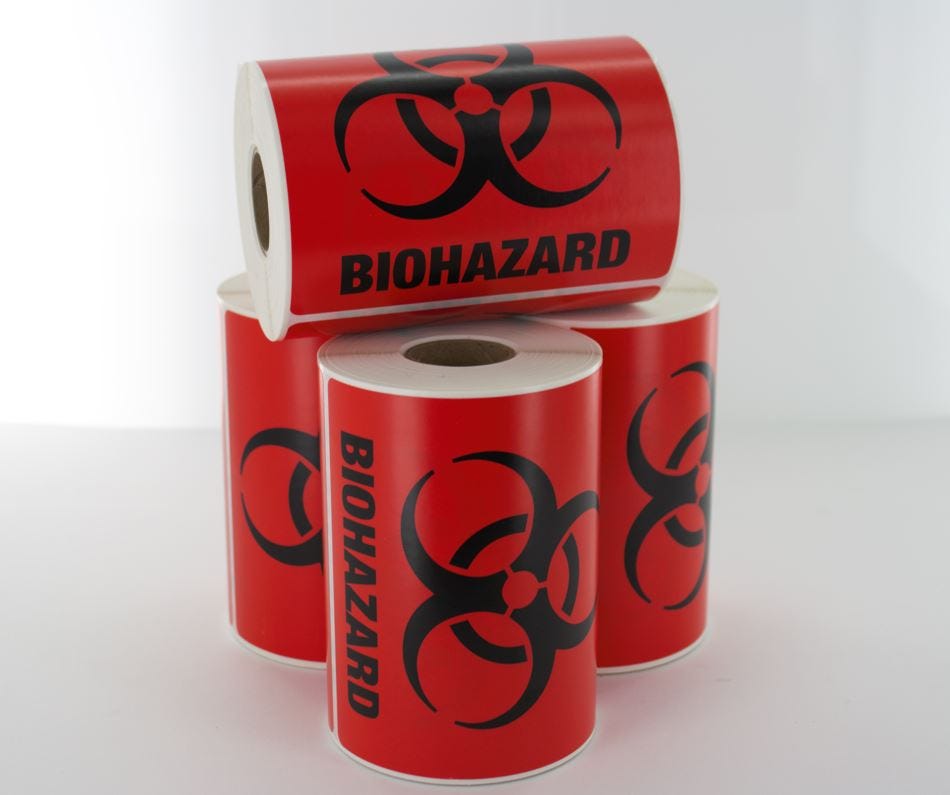The Different Types Of Hazardous & Biohazard Stickers
- By LabelValue Team
- Apr 3, 2023
Hazardous waste can create many problems for human health and the environment if not disposed of properly. This is why special measures and laws exist to properly dispose of and label biohazard materials.
There is about 44,000 facilities in Florida that generate biomedical waste. This biohazard waste comes from hospitals, clinics, nursing homes, laboratories, and funeral homes.
Hazardous labels are essential for identifying and warning against hazardous materials, substances, and chemicals in various industries. They are particularly important in the transport and storage of hazardous materials, such as waste, chemicals, pesticides, and explosives. Hazardous labels must comply with various regulations and guidelines, including those set forth by the United Nations, the U.S. Department of Transportation (DOT), the Occupational Safety and Health Administration (OSHA), and other regulatory bodies.
Hazardous Material Regulations & Labeling
Biohazard stickers warn humans of hazardous materials. These health risks include microorganisms, toxins, human waste, poisons, and sharp objects. Stay biohazard compliant when using biohazard materials and waste.
When purchasing hazardous materials, it is essential to ensure that the products are properly labeled and packaged. Buyers must also ensure that the labels comply with all relevant regulations and guidelines. Hazardous labels must provide clear and accurate information about the contents of the package, including the potential hazards and risks associated with the materials. This information allows handlers and users of the materials to take appropriate precautions to ensure their safety and that of others.
In addition to complying with regulatory requirements, the use of hazardous labels also helps to prevent accidents, injuries, and damage to property. By clearly identifying the potential hazards associated with hazardous materials, handlers and users can take appropriate precautions, such as wearing protective equipment, storing the materials in a safe and secure location, and following proper handling and disposal procedures.
Keep your transportation company safe with UN, BSL1-4 biohazard labels. Many laboratories used DOT (department of transportation) labels when transporting their biohazard materials. Custom-printed biohazard labels can be purchased here.
Types of Hazardous Labels and Colors
Hazardous labels are typically color-coded to provide quick identification of the type of hazard associated with the materials. For example, the color red is used for flammable materials, while the color blue is used for health hazards. The labels may also include pictograms, symbols, and text that provide additional information about the hazards associated with the materials.
Large Biohazard Stickers
Large 4" x 4" square biohazard labels are perfect for labeling large biohazard barrels, containers or shipments. These bright fluorescent labels will alert people of biohazard materials. With 250 labels per roll you can peel and stick these labels where needed. Stay compliant with FDOT when transporting biohazard waste. Or Use these labels for Biosafety BSL1, BSL2, BSL3, or BSL4. Another use these biohazard stickers can be used for are Category A UN 2814, Category B UN 2900, or Category B UN 3373.
Small Biohazard Contaminated Stickers
Small biohazard stickers are perfect to label smaller hazardous waste bins. Or you can label smaller trash cans with these labels.
Autoclave Biohazard stickers
Autoclave biohazard labels can be used to label tools that need to be autoclaved. Autoclaved is a process where steam is used at high pressure to clean and remove all bacteria. This is common in the medical industry for medical tools. Many medical tools and devices are sterilized with autoclave to ensure it is sanitized.
Hazardous materials
Organize your hazardous chemical waste labels by type. Add the date, who processed it, and the department for tracking and visibility purposes.
Class 9 Hazard Labels
Class 9 Miscellaneous labels are used for a variety of hazards. These hazardous labels are used for any hazardous material that does not fit into the regular categories. Some examples for use of class 9 hazard labels are for environmentally hazardous substances, miscellaneous hazards, micro-organisms, magnetized materials, and aviation substances.
Any hazardous material outside of explosives, blasting agents, poison, radioactive, flammable gas, inhalation hazards, dangerous or corrosive can be used with a class 9 hazard label.
Hazardous labels play a critical role in the safe handling and transport of hazardous materials. Buyers of hazardous materials must ensure that the products are properly labeled and packaged and that the labels comply with all relevant regulations and guidelines. By following proper labeling and handling procedures, buyers and users of hazardous materials can help prevent accidents, injuries, and damage to property, and ensure the safety of themselves and others.
Browse All Biohazard Waste Labels

 Save 10% off your first LabelValue order |
Save 10% off your first LabelValue order | 




